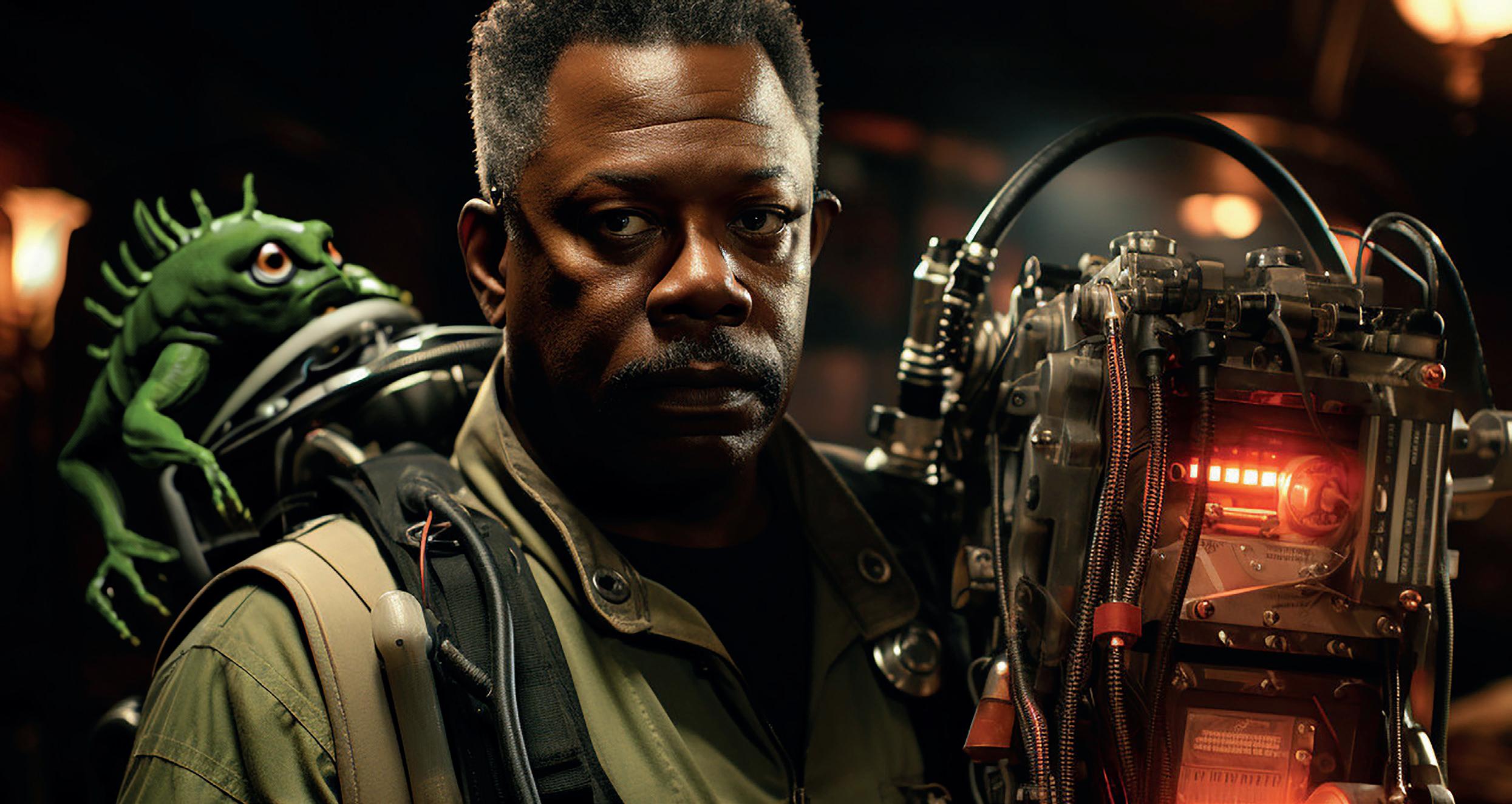
8 minute read
MORE HUMAN THAN HUMAN
Mark Gash explores authenticity in an age of AI and reckons you can’t fake Bill Murray.
When ChatGPT first strutted onto the scene early last year, the gang here at Dirtyword HQ were blown away. In our “other” roles as e-learning developers (yes, we’re just like you!), we had battled for years with clients supplying us with rough notes, PowerPoint slides and napkin scribbles that they wanted us to magically turn into coherent online courses with considered learning pathways and outcomes. And whilst we had mastered the art of making “summat outta nowt”, it was rarely an enjoyable or fulfilling experience. Writing and structuring courses isn’t the fun part for us - creating interactive experiences is where we get our jollies.
So, to suddenly find ourselves with a tool that we could feed with scraps of information and have it spit out fully written course copy, with logical progression and assessment questions, was too good to be true. A few minutes in ChatGPT, then send it back to the client for sign-off, leaving us with the time, energy and enthusiasm to crack on with the fun stuff.
It never actually ran as smoothly as that, of course. Clients will be clients, and they love to feel part of the process, so cue many rounds of revisions. And to be fair, it’s not as though AI always got it right, nor included everything that needed to be in a course. But it was a good starting point and sometimes that’s exactly what you need to get the juices flowing.
Fast forward 12 or so months, and where are we? Well, now every woman and her cat is using AI to write everything from online courses to marketing blogs and angry emails to the bank. It really has revolutionised how people write, both in a professional and personal capacity. And now that it’s everywhere, isn’t it all starting to read a bit samey? Almost as if one person has written it. Even when you specify that it’s written in a particular style, it feels as though it’s doing an impression. Like how the voice artist Lorenzo Music, who did Peter Venkman’s voice in The Real Ghostbusters cartoon, sounded not quite like Bill Murray’s character from the original movie (and weirdly, Lorenzo was also the voice of Garfield in the cartoon, yet when they made a Garfield movie, they had Bill Murray voice the ginger cat). As good as ChatGPT, and AI in general, is, it lacks authenticity. And now that the lasagna-loving cat is out of the bag, with the world using it to communicate, the vast majority of the output comes across as bland noise.

The worry is that this is only going to get worse as AI evolves. We are told that ChatGPT was originally trained on a huge swathe of data involving human interaction and linguistics. It looked at billions of examples of how people communicated with each other - how they wrote emails, texts, tweets, blogs, scripts and news articles. It then used this information to learn how to write like a human, even specific humans such as celebrities.
Going back to my earlier example, if you wanted to sound like Bill Murray, you’d watch and listen to hours worth of Bill Murray in films, performing stand-up and being interviewed. Eventually, you’d pick up on his accent, pronunciation and stylistic quirks to be able to do an adequate impression of the actor. You’d be the envy of all your friends! Then imagine your friend gets jealous of all the attention you’re getting for your awesome Murray impression, so he decides he also wants to sound like Bill Murray. He could follow the same process you did, watching films, listening to interviews, or he could just copy you - you probably learnt loads of ways to get the voice right, and it would be faster and easier to ask for your help. But then, is that friend really doing an impression of Bill Murray, or is he doing an impression of you, doing an impression of Bill Murray? And what if his friend wanted to learn it too? Would that friend copy your friend? Eventually, you have 100 people who all do a vague impression of Bill Murray, based off the research one person undertook at the start. Not to mention, you may have got it wrong. What if you were actually doing an impression of Dan Ackroyd but told everyone it was Bill Murray. And that’s ChatGPT. As more people use AI to write their day-to-day output, the percentage of genuinely human-generated pieces of copy starts to dwindle. So as ChatGPT undertakes its next round of training, it’s going to consume a huge amount of AI-generated content i.e. chatbots doing impressions of humans. The bland inauthenticity, along with any mistakes, will grow as AI continues to consume and recycle its own work, until we’re all drowning in a sea of bad Dan Ackroyd-posing-as-Bill Murray impressions.
What’s the answer then? In a world of AI content, how do you make your online course, or any written copy, stand out from the uniformity of word-perfect articles and precise sentence structure that ChatGPT delivers? Because here’s the rub - AI isn’t bad at what it does at all. And although it seems like I’m trying to lead a revolution against generative AI, I’ll put my hands up and admit that it’s amazing. It can write content way better than I can - it wouldn’t waffle on about 80’s movie stars or insert obscure cartoon references that most of the readership won’t understand. This article will be full of flaws, and some people will read it and just wish I’d get to the point.
And that is the point - “To err is human.” AI is too perfect, even when it’s wrong, it convinces you it’s right as it masquerades as a human. To stand out, you need to be more human than AI. More human than human.
Be authentic and use your own voice.
An authentic voice creates trust in you and the information you’re presenting. When writing your online courses, don’t be afraid to take detours, make jokes or ramble conversationally.
As long as you eventually bring it back to your learning outcomes, your audience will enjoy the journey.
Big yourself, and your subject, up.
If you’re writing a course, then you must be pretty knowledgeable in that subject right? So shout about it. It’s taken you years and countless lived experiences to distil your knowledge - something that AI can’t lay claim to. Don’t just present facts; tell your story.
Connect with your audience.
You’re writing a course for a specific group of people - even if all you know about those people is that they’re interested in your subject, then that still gets one over on AI. Think about what made you excited about the subject in the first place and use that in your writing. If you teach passionately, it will resonate with your audience and they will learn passionately.
Get creative.
Think about your own experiences and apply them to the structuring of your course. People learn in different ways, and a linear course isn’t always the most exciting or effective way of presenting ideas and information. The technology exists to place learners in virtual worlds and environments, so don’t be afraid to look at the learning journey from a new perspective and add your own twist to keep people interested and engaged. This is especially true if your subject matter is a bit dry - AI would have a hard time making a boring lesson interesting but you don’t have to play by AI’s rules.
Encourage Dialogue.
Buck the trend of AI chatbots and make yourself available to your learners, whether it’s through forums, webinars or even live workshops. Make yourself the source of information, not ChatGPT. It will allow you to grow people’s understanding of your subject whilst acting as a standards check against the growing tide of dubious information available from AI sources.
Adopting a More Human Than Human approach and considering the above in your course writing means your content will remain distinguishable from the automated output of AI. You’ll know that the content you produce will be not only accurate but also more likely to connect with your learners, making e-learning more rewarding for you and your audience.
Right, I’m off to watch the new Ghostbusters film.











